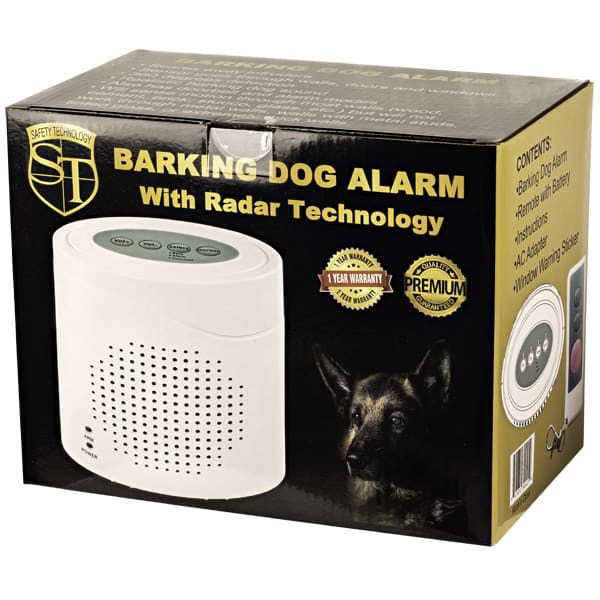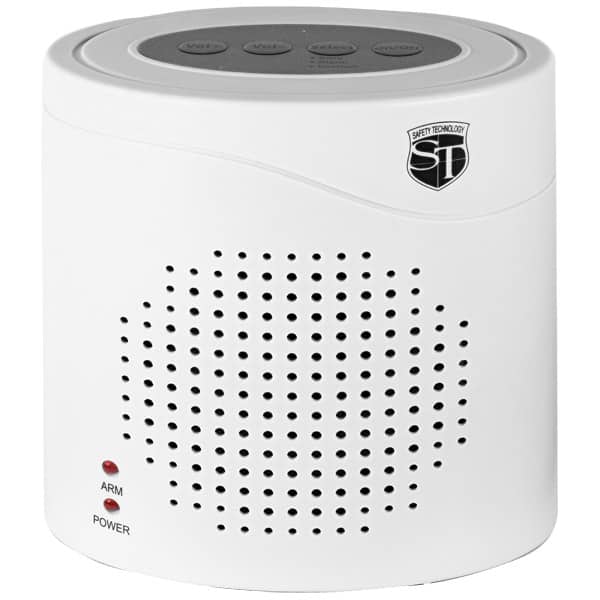
Brainstorm Security Shop

For Orders Over $199

On Any Of Our Products

Details On Refund Page
Have you ever considered enhancing your home security with a barking dog alarm that boasts an extended battery life? These innovative devices not only deter potential intruders with realistic barking sounds but also offer the convenience of less frequent battery changes, thanks to their energy-efficient design. You’re likely curious about how these alarms can adjust to different sensitivity levels and what makes their battery life superior to others on the market. While the technology behind these systems is quite fascinating, the real question is whether they live up to the hype in practical scenarios. What are your thoughts or experiences with such security measures?
Barking dog alarms simulate the sounds of a real dog barking, offering an effective deterrent against potential intruders. You might wonder how these devices mimic barking behavior so convincingly. It’s all about the technology that captures the essence of a guard dog’s alertness without the need for an actual dog.
These alarms are equipped with sensors that adjust their sensitivity based on the environment. This means they can distinguish between normal outdoor noises and those associated with a possible break-in. When a threat is detected, the alarm triggers a barking sound that intensifies, mimicking the natural escalation of a dog when it senses an intruder.
Adjusting the alarm sensitivity is crucial. You don’t want it going off at every car passing by, right? That’s where tuning the sensitivity settings comes into play. By setting it correctly, you ensure that the alarm reacts primarily to legitimate threats, thereby minimizing false alarms and maintaining the alarm’s credibility as a security measure.
Understanding how to optimize these settings can significantly enhance the alarm’s effectiveness. This knowledge puts you in control, allowing you to tailor the alarm’s response to your specific security needs.
When you’re choosing a barking dog alarm, you need to consider how long it’ll last before needing a recharge.
Look for alarms that boast extended battery performance and efficient power management.
These features ensure your alarm keeps running longer, giving you better security and peace of mind.

To maximize your security without frequent battery changes, opt for a barking dog alarm with extended battery performance. These alarms utilize cutting-edge battery technologies designed to last significantly longer, ensuring your home stays protected without constant maintenance.
By leveraging advanced energy efficiency methods, these devices draw less power during operation, which drastically cuts down on the need for battery replacements.
You’ll find that the latest models come equipped with batteries that not only have a higher capacity but are also better at sustaining their charge over time. This means you’re not just getting a device that lasts longer per charge, but also one that holds its performance over the years.
You won’t be caught off-guard by a dead battery when you need protection most.
Moreover, these alarms are built to be robust. They can withstand various environmental conditions without draining the battery excessively.
Whether it’s extreme cold or heat, the alarm maintains its efficacy, thanks to the resilient battery technology employed.
Efficient power management often plays a crucial role in the longevity and reliability of your barking dog alarm. By optimizing how your device conserves power, you’re not just extending its operational life but also ensuring it works efficiently when you need it most. Let’s dive into the key features that contribute to effective power management.
Firstly, you’ll want to look at the energy efficiency of the alarm system. A model designed with power conservation in mind operates without draining excessive battery power, thereby increasing the intervals between charges or battery replacements. This means you won’t find yourself frequently changing batteries or facing a non-functional alarm when an intruder approaches.
To give you a clearer picture, here’s a breakdown of features that enhance the power management of your barking dog alarm:
| Feature | Benefit | Impact on Power Use |
|---|---|---|
| Adjustable Sensitivity | Reduces false triggers | Lowers energy consumption |
| Sleep Mode | Conserves power when inactive | Extends battery life |
| Low Power Alert | Notifies you before power is depleted | Prevents unexpected shutdown |
Understanding and utilizing these features ensures your alarm remains active and effective without unnecessary power wastage. You’re investing in security that’s reliable and conscious of energy use!
Extended battery life in your Barking Dog Alarm ensures you don’t have to worry about frequent recharges. This offers not just peace of mind but also significant cost savings. You’re not constantly buying batteries or paying for electricity, which adds up over time.
Plus, the longer lifespan of the battery means you’re not disposing of batteries as often, reducing your environmental impact.
Technological advancements have made these alarms more energy efficient, which translates to better performance without sacrificing power. This is crucial, especially in emergency situations where you rely on your alarm for safety and security. The last thing you need is a dead alarm when it matters most.
Extended battery life ensures your home is protected continuously, without interruptions.
Moreover, user convenience is greatly enhanced. You don’t have to check and replace batteries frequently, which is a boon if the device is in a hard-to-reach place.
Longer battery life also means the product itself can last longer, as it’s not subjected to the wear and tear of constant battery changes. This all culminates in an alarm system that’s not just reliable but also a smart investment for your safety.
Installing your Barking Dog Alarm is straightforward and can be done by anyone, regardless of technical skill.
You’ll first need to choose a strategic location for your device, ideally where it can best detect motion without obstructions. Once you’ve picked the spot, the setup involves minimal tools and is primarily focused on configuring wireless connectivity and alarm sensitivity.
Start by ensuring that the device is powered and in pairing mode. You’ll find a button on the side labeled ‘Pair’ or ‘Connect’. Press this and wait for the indicator light to blink, signifying that it’s ready to connect to your Wi-Fi network.
Follow the prompts on your smartphone or tablet to complete the connection process.
Next, adjust the alarm sensitivity. This setting determines how much movement is needed to trigger the alarm. It’s crucial to find a balance that minimizes false alarms but ensures the alarm reacts to genuine threats.
Experiment with different sensitivity levels until you find one that suits your environment.

Considering the variety of Barking Dog Alarms available, it’s important to compare top models to find the one that best fits your needs.
When you’re looking at model specifications, pay close attention to the range of detection, volume control options, and types of batteries used, as these can greatly influence the device’s effectiveness and convenience.
First, let’s consider the GuardDog-1000. It’s praised in user reviews for its realistic barking sounds that adjust in intensity as intruders come closer.
The model also boasts a wireless setup, making it incredibly easy to install anywhere in your home.
Next up, the SentryBark V2 is another popular choice. Users love its long battery life and the fact that it includes a remote control for ease of operation.
The model also features an adjustable sensitivity scale, which means you can tailor it specifically to the size of your property.
Lastly, the DefenderCanine XE offers a unique feature of recording your own dog’s bark, adding a personal touch to the alarm system.
User reviews highlight its robust construction and the effective deterrent it provides against potential intruders.
Choosing the right model involves weighing these features against what’s most important for your security needs.
How often do you consider the maintenance of your Barking Dog Alarm? Keeping your alarm in top shape isn’t just about reacting when something goes wrong; it’s about regular upkeep to ensure longevity and optimal performance.
Here are a few tips to help you maintain your device effectively:

As you explore real-world feedback on the Barking Dog Alarm, you’ll find varying opinions on device reliability, from flawless operation to frequent malfunctions.
Users often highlight its impact on home security, noting whether it truly deters intruders or simply annoys neighbors.
Additionally, comments on battery performance can give you insights into how often you might need to replace or recharge batteries.
Many users have reported issues with the reliability of their barking dog alarms, noting frequent false alarms and occasional failures to activate when needed. While the concept is innovative, the execution appears to have left some room for improvement. You might find yourself frustrated by these inconsistencies, especially when you rely on this device for home safety.
User feedback highlights several common concerns:
These issues suggest a need for ongoing improvements in technology and design to enhance device reliability and user satisfaction.
Given the reliability issues outlined previously, you might wonder about the real-world impact these barking dog alarms have on home security. Despite some concerns, numerous users have reported significant improvements in their sense of safety. The alarms’ ability to mimic a fierce dog bark has proven to be a strong deterrent against potential intruders.
It’s not just about the noise; it’s the implication of what’s behind that noise—a protective, possibly aggressive, dog. In communities where these alarms are popular, there’s a noticeable uptick in neighborhood safety. People feel safer knowing that the mere sound of a barking dog can ward off unwanted visitors.
The psychological effect can’t be understated; it often prevents attempts before they even start. You’ll find that the deterrent effectiveness of these alarms has made them a favorite among those who prefer not to own real dogs due to allergies or other reasons.
Feedback consistently highlights how these alarms maintain a vigilant presence, day and night, contributing to a fortified home environment. By integrating this tool into your security setup, you’re not just installing a device; you’re enhancing your home’s defense layer in a cost-effective, maintenance-free way.
How long do the batteries last in a barking dog alarm? You might find yourself asking this question as you consider the practicality of such a device in your home security setup. The answer largely depends on the battery types used and the device’s power management features.
Real-world user experiences suggest that battery performance can vary widely, but here are three key insights:
From these points, it’s clear that choosing the right batteries and managing usage and environmental factors are crucial for maximizing the lifespan of your barking dog alarm’s batteries.
You’ll want to keep these in mind to ensure optimal performance and avoid frequent battery replacements.

When selecting the right model of a barking dog alarm, it’s crucial to weigh your specific needs against the features offered. Two key features to consider are barking frequency and alarm sensitivity. These can greatly impact the effectiveness of your alarm depending on your specific situation.
Barking frequency refers to how often the alarm emits a barking sound when triggered. If you’re in a busy area, a higher frequency might be necessary to deter potential intruders effectively. However, if you’re in a quieter, more secluded area, a less frequent bark might suffice and help conserve battery life.
Alarm sensitivity is another crucial factor. This determines how easily the alarm is triggered. A highly sensitive alarm can be beneficial in high-security areas as it reacts to the slightest movements. Yet, this can also lead to more false alarms, which might be a nuisance.
On the other hand, a less sensitive model could miss genuine threats if not adjusted correctly.
You’ll also want to think about the size of the area you need to monitor. Larger areas might require more powerful models with wider detection ranges. Always check the product specifications to ensure they meet your expectations and security needs.
You’re wondering if the device can tell the difference between an actual dog’s bark and a person’s voice.
Yes, it’s equipped with bark detection and voice recognition technologies. This means it can distinguish between the two sounds effectively.
You won’t have to worry about it misinterpreting a conversation as a bark, as it’s designed specifically to recognize the unique characteristics of each sound, ensuring it reacts appropriately to actual barks.
Yes, the alarm’s volume is adjustable, allowing you to tailor it to the size of your space.
You’ll find various installation options, so you can optimize sound sensitivity whether you’re in a cozy studio or a large warehouse.
Just tweak the settings to ensure it’s loud enough to be heard or subtle enough to blend in, depending on your needs.
This flexibility makes it an excellent choice for both personal and professional environments.

Extreme temperatures can definitely impact your barking dog alarm battery’s longevity.
If it’s exposed to very hot or cold conditions, you might notice a decrease in performance. This can be particularly challenging if you’re relying on consistent functionality for security or convenience.
To ensure optimal performance, try to keep your device within a moderate temperature range. This will help maintain the battery’s efficiency and extend its lifespan, keeping you worry-free about sudden failures.
You’re in luck—there are no subscription fees with this alarm.
It operates on a one-time purchase basis, so you don’t have to worry about monthly or annual payments.
This model avoids the hassle of a subscription model entirely, making it easier and more cost-effective for you.
Just make your purchase, set it up, and enjoy the security without ongoing financial commitments or complicated payment options.
Yes, the alarm can connect to smart home systems like Alexa or Google Home.
This feature allows you to integrate it seamlessly into your existing smart home setup.
With voice command compatibility, you can easily control the alarm, activate or deactivate it, and even adjust settings using just your voice.
It’s a convenient way to enhance your home security without needing to manually interact with the device each time.
You’ve seen how barking dog alarms with long battery life can boost your home security while saving you time and hassle. By choosing a model with adjustable settings and extended battery life, you’ll enjoy peace of mind, knowing your home is protected around the clock. Remember to follow the simple installation steps and maintain your alarm properly to maximize its effectiveness. Now, you’re ready to compare models and find the perfect fit for your safety needs.

Brainstorm Security Shop
1867 Caravan Trail
Ste 105
Jacksonville, FL 32216
Call us toll free: (800) 859-5566